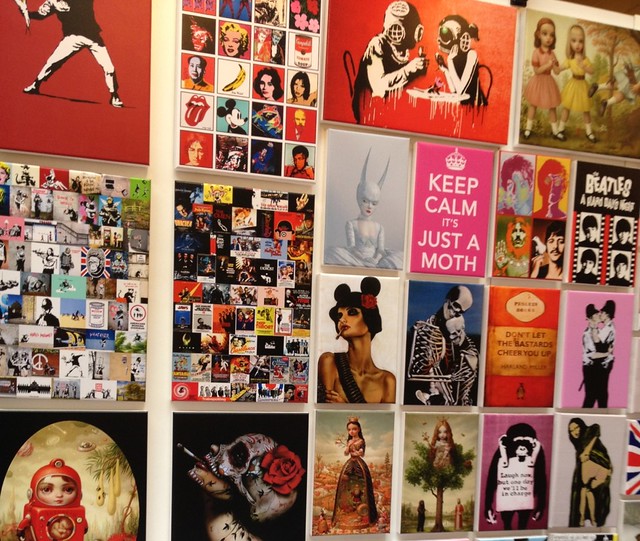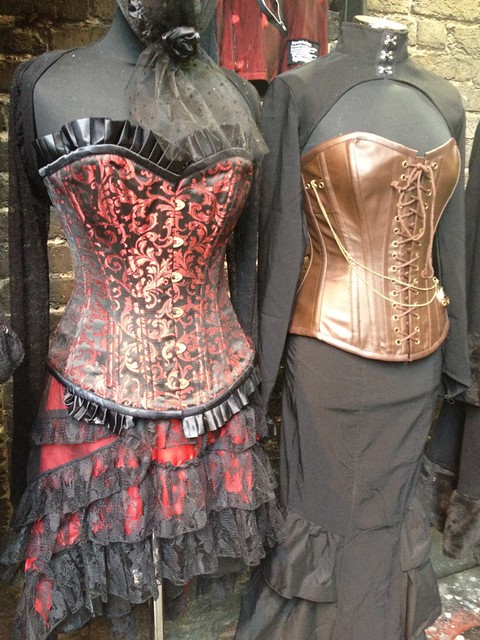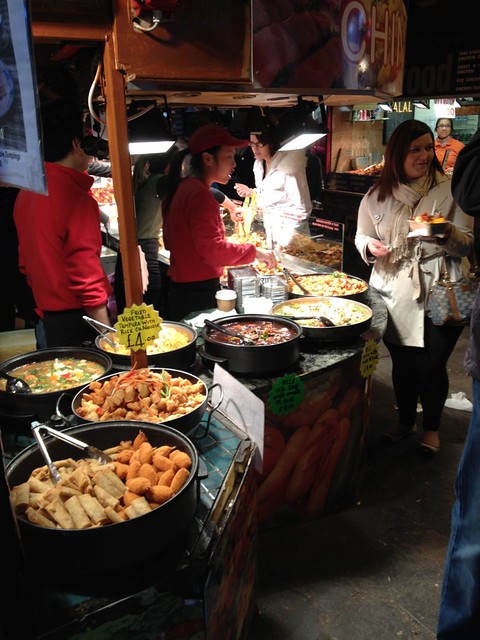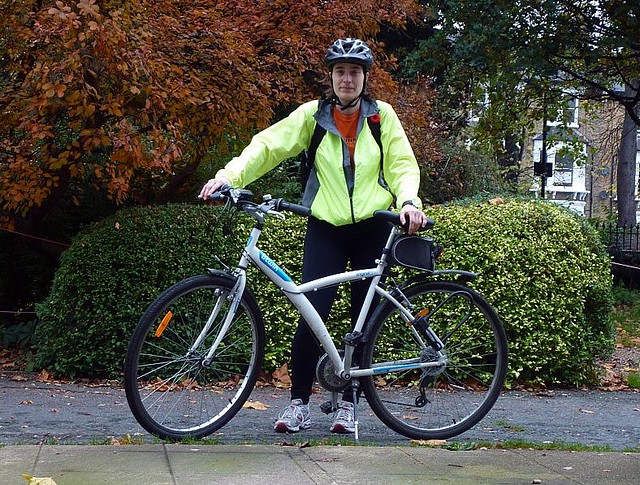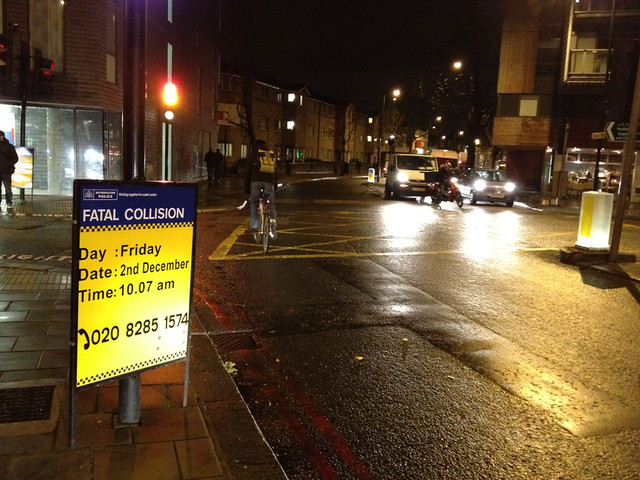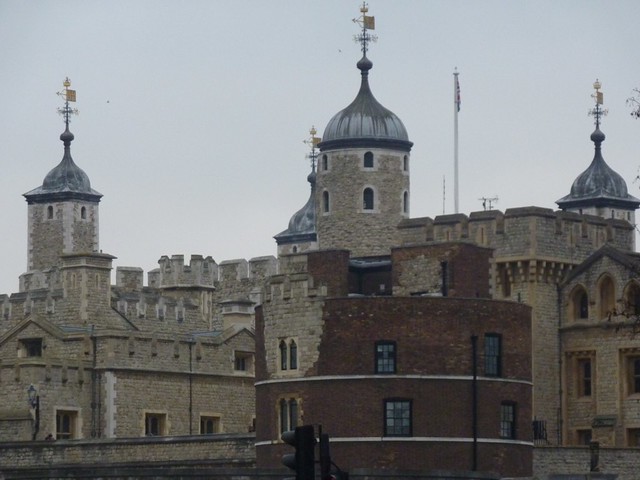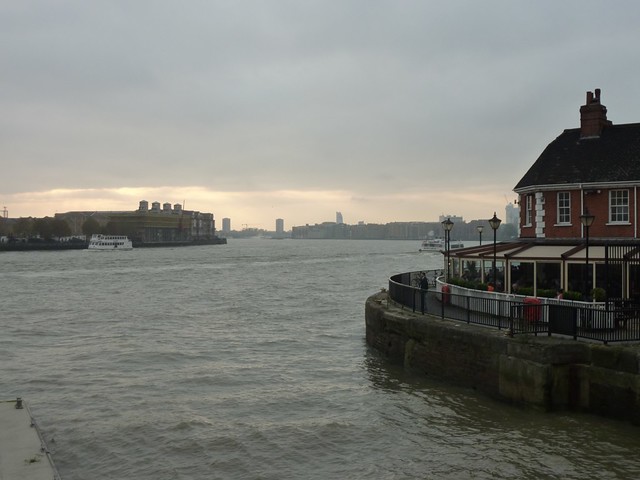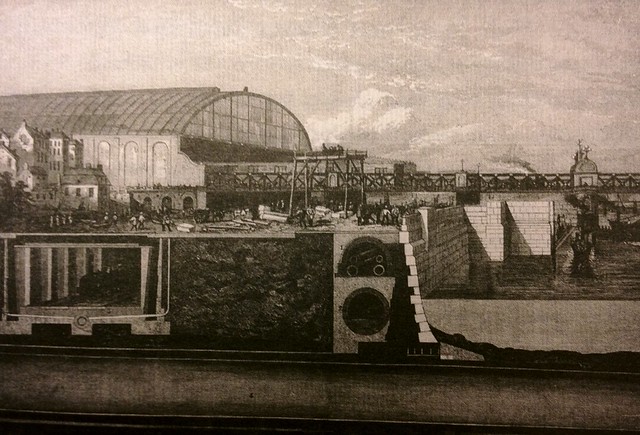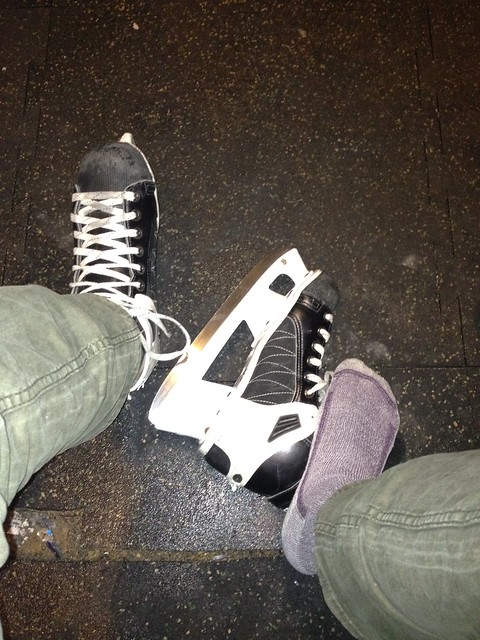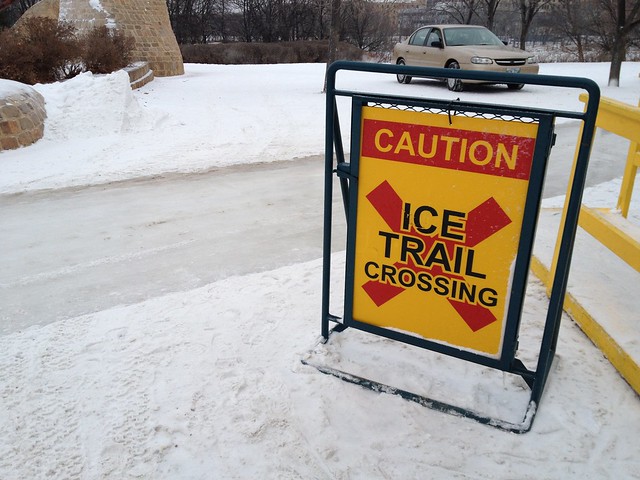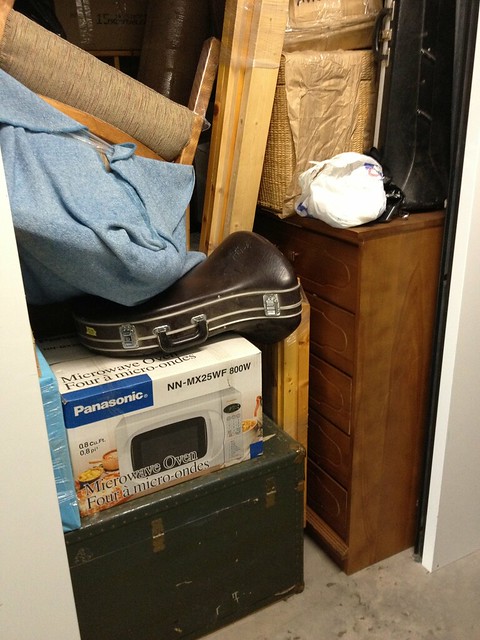Life took me up to Camden Town this weekend, where the Northern line's Charing Cross and Bank branches join briefly before striking off in separate directions again. (Can someone please explain to me why the Northern line isn't actually two different lines? I mean, look at the map! It could easily be one line from Edgware in the North via Charing Cross to Morden in the south, and a whole separate line from High Barnet in the north via Bank to Kennington. Why is that one line, when the Circle and the District lines are completely coincident over much of their run through central London and yet they are two different lines? These are the things that keep me up at night...)
But back to Camden - a trendy area in north London centred where Camden High Street crosses the Regent's Canal. It's well known as a spot for alternative culture, live music venues, and, perhaps most especially, for Camden Market. Since I was there anyways, and was enjoying a sort of extended birthday weekend, I thought I'd have a wander through the market, snap a few pictures, and see if I could squeeze a blog post out of it all.
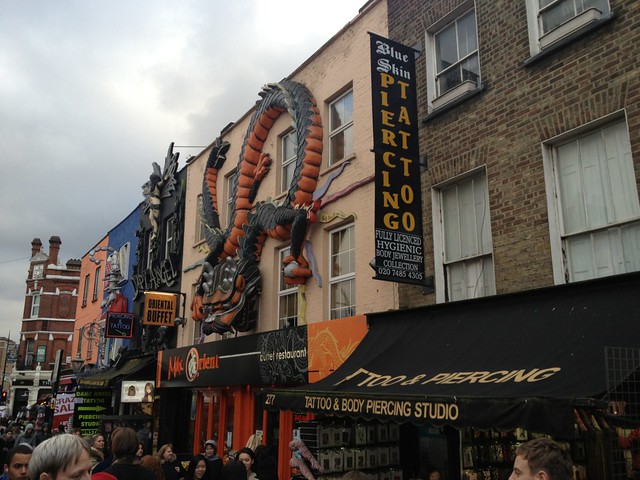 Camden High Street, being all alternative-like. This was one of a horde of tatto and piercing places along the road.
Camden High Street, being all alternative-like. This was one of a horde of tatto and piercing places along the road.
Camden Market is actually a semi-connected series of covered markets that extends over a seemingly-endless area just north of the canal. The Wikipedia article on the market claims that it's the fourth most popular tourist attraction in London, which I find a bit hard to credit, given the competition (the Tower of London, London Eye, Buckingham Palace, Tower Bridge, the British Museum... do I need to go on? Because I most certainly can.) (Also, the link in the footnote to that particular statistic was dead, so I have no idea where it came from. And though Wikipedia is generally pretty good, the fact is that bit could have been stuck in by the Greater Camden Council For Made Up Statistics And General Falsehood Of All Kinds.) Regardless, the market is hugely popular, mostly on weekends. So popular, in fact, that Camden Town tube station closes to outbound passengers on Sundays because the number of people arriving and disgorging from the station is so huge.
The site of the market, along the canal, is no coincidence. The coming of the Regent's Canal in the late 19th century brought goods and trade to Camden causing warehouses to be built along the canal. However, that trade faded quickly with the advent of newer forms of transport (rail, I'm guessing, but don't quote me on that...) and that area of Camden declined until the 1970s. That's when a few bright sparks decided to apply for permission from British Waterways to start a small arts and crafts market in some of the abandoned warehouse space.
Now Camden Market spreads across about six different sites, including warehouses, stables, and standalone market stalls. I had no idea of the extent of the market until I really started wandering, and then realised what a labyrinth it is. I found myself squeezing through narrow paths between stalls, sometimes going around in circles but only realising it because I'd recognise some distinctive bit of merchandise ("Ah, the spinny mirrory mobile thingies... that must mean the donut guy is over here... oh wait...")
The market really is overwhelming with an amount and array of stuff on sale that is slightly staggering. Here's a list I compiled during my aimless wandering: T shirts with stupid motifs on them, goth/alternative clothing, jewellery, flat caps, wooly hats (aka toques), ball caps, pork pie hats, top hats, funny kids hats, all manner of bags, leather goods, antiques, bicycles, endless London tourist crap, sweaters (aka wooly jumpers), CDs, DVDs, LPs, scarves, watches, rings, watches ON rings, pocket watches, smelly soaps, aprons, ceramics, bracelets made from forks and spoons, airplanes made from beer cans, marble coasters, mitts, mobiles (the kind you hang up), phone accessories, eyebrow threading, henna tattoos, hoodies, posters and artwork, belt buckles, ear muffs, stuff with sequins, sunglasses, gemstones and healing crystals, melted glass bottles turned into coasters and clocks, lamps, rugs, signs, hammocks, new and used books, purses, and, of course, boxer shorts with the tube map on them.
The other thing that there's a lot of at Camden Market is food and drink. I kind of wish I'd arrived hungrier, because I could have gorged on an almost endless variety of foods, including the fresh-from-the-fryer donuts above. There was a world's worth of cuisine, including Chinese, Lebanese, Mexican, Indian, Cuban, Thai, Italian, Turkish, and Ethiopian. I could have drunk coffee, tea, chai, hot chocolate,beer, glog, mulled wine or smoothies, and I could have eaten vegetarian, vegan, falafel, waffles, crepes, pizza, kebabs, sausages, crepes, candy, fudge, sweet or savoury corn pancakes, some deep-fried things called "Dutch Dunkers", artisinal chocolates, whole roast hog (though I was really not THAT hungry), fish and chips, tapas, dim sum, chocolate covered bananas, churros, cakes of all kinds, ostrich or kangaroo burgers, fancy mac and cheese or fajitas. Oh, and pie and mash!
The thing I found strange is something I've noticed about London in general. Even though it was a decidedly chilly day there were lots of people sitting at outdoor tables scattered around the market, eating their vegan falafel and gourmet mac and cheese. This just seems unnecessarily grim to me. I understand that we weren't in the teeth of a howling blizzard but it was still cold enough to be wearing gloves (£3 from a market stall) and despite the exceedingly enticing smells coming from many of the food vendors, I had no desire whatsoever to huddle at a picnic table trying to shovel down a pizza before it turned into a frozen Frisbee. It reinforced my general suspicion that people over here are preconditioned to accept a certain degree of physical discomfort as a part of life. It gives them something to either whinge about, or have a stiff upper lip about, depending on mood. Bill Bryson writes a bit about this, probably in "Notes from a Small Island", when he relates the charming habit of the English to do things like climb up hills in a steady rain with their trouser legs tucked into their socks and then sit at the top, still in the rain, unwrap a sad sandwich, have a cup of rapidly cooling tea from a Thermos and perhaps (naughty!) a dry biscuit, and proclaim the whole experience to be "lovely".*
So I left the market and camped out at a nice vegan place on Camden High Street where I had a latte and a very rich bit of chocolate cake sort of stuff and nestled up to the heater under the table. And I took this photo, which for some reason I regard as vaguely art-y, so I include it here.
And that was my afternoon at Camden Market. I'd certainly recommend it if you're visiting London and are weary of museums and galleries and yet feel like something a bit more outré than Portobello Road. It's got a good measure of stuff worth buying, mixed with a lot of stuff (and people) worth having a gawk at. And try the kangaroo burger, just for me.
P.S. More photos of the market appear in the "Camden Market" set at Flickr.
* Having now consulted "Notes from a Small Island" I realise I may have completely fabricated this remembrance, but stand by its essential truth nonetheless. And I think Bill would back me up on this too.
But back to Camden - a trendy area in north London centred where Camden High Street crosses the Regent's Canal. It's well known as a spot for alternative culture, live music venues, and, perhaps most especially, for Camden Market. Since I was there anyways, and was enjoying a sort of extended birthday weekend, I thought I'd have a wander through the market, snap a few pictures, and see if I could squeeze a blog post out of it all.
 Camden High Street, being all alternative-like. This was one of a horde of tatto and piercing places along the road.
Camden High Street, being all alternative-like. This was one of a horde of tatto and piercing places along the road.The site of the market, along the canal, is no coincidence. The coming of the Regent's Canal in the late 19th century brought goods and trade to Camden causing warehouses to be built along the canal. However, that trade faded quickly with the advent of newer forms of transport (rail, I'm guessing, but don't quote me on that...) and that area of Camden declined until the 1970s. That's when a few bright sparks decided to apply for permission from British Waterways to start a small arts and crafts market in some of the abandoned warehouse space.
Regent's Canal and the Hampstead lock, with a small slice of Camden market on the right and, inevitably, a Starbucks in the white building on the left.
Now Camden Market spreads across about six different sites, including warehouses, stables, and standalone market stalls. I had no idea of the extent of the market until I really started wandering, and then realised what a labyrinth it is. I found myself squeezing through narrow paths between stalls, sometimes going around in circles but only realising it because I'd recognise some distinctive bit of merchandise ("Ah, the spinny mirrory mobile thingies... that must mean the donut guy is over here... oh wait...")
A bit of one stall selling stuff to put on your walls. I particularly like the Penguin book in the bottom right. Banksy, double-decker buses, red phone boxes, variations on the "Keep Calm" poster, London street signs and Union flags are popular themes at these kind of stalls. (Aside: apparently it's properly referred to as a "Union Jack" only when it's on board a ship... you learn these things when you're working on a show in which flags play an important part.)
And here's a slice of the goth/alternative/whatever flavour of the market. Apologies if I've failed to identify whatever slice of subculture this mode of dress belongs to but really, who cares other than the people involved? They are welcome to enlighten us all in a comment below.
Like I said... endless amounts of London themed tourist tat. (Another aside: I'm a bit of a sucker for this stuff. Friday night I found myself with a bit of time to kill in the West End, and I went and bought myself a ceramic double-decker bus piggy bank, which is perfectly excellent.)
Lots of these vendors were giving out free samples to suck people in. It's just like Costco!
The thing I found strange is something I've noticed about London in general. Even though it was a decidedly chilly day there were lots of people sitting at outdoor tables scattered around the market, eating their vegan falafel and gourmet mac and cheese. This just seems unnecessarily grim to me. I understand that we weren't in the teeth of a howling blizzard but it was still cold enough to be wearing gloves (£3 from a market stall) and despite the exceedingly enticing smells coming from many of the food vendors, I had no desire whatsoever to huddle at a picnic table trying to shovel down a pizza before it turned into a frozen Frisbee. It reinforced my general suspicion that people over here are preconditioned to accept a certain degree of physical discomfort as a part of life. It gives them something to either whinge about, or have a stiff upper lip about, depending on mood. Bill Bryson writes a bit about this, probably in "Notes from a Small Island", when he relates the charming habit of the English to do things like climb up hills in a steady rain with their trouser legs tucked into their socks and then sit at the top, still in the rain, unwrap a sad sandwich, have a cup of rapidly cooling tea from a Thermos and perhaps (naughty!) a dry biscuit, and proclaim the whole experience to be "lovely".*
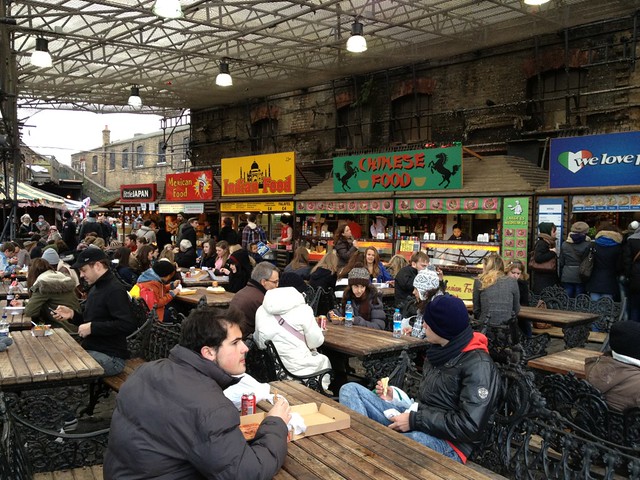 |
| I, on the other hand, having grown up in North America, have it coded in my DNA that I have a right to physical comfort at all times. For God's sake people, GO INSIDE! |
Hemp milk! And I had some kind of fake whipped cream substitute made from RICE with my chocolate cake. Those wacky vegans...
And that was my afternoon at Camden Market. I'd certainly recommend it if you're visiting London and are weary of museums and galleries and yet feel like something a bit more outré than Portobello Road. It's got a good measure of stuff worth buying, mixed with a lot of stuff (and people) worth having a gawk at. And try the kangaroo burger, just for me.
P.S. More photos of the market appear in the "Camden Market" set at Flickr.
* Having now consulted "Notes from a Small Island" I realise I may have completely fabricated this remembrance, but stand by its essential truth nonetheless. And I think Bill would back me up on this too.



